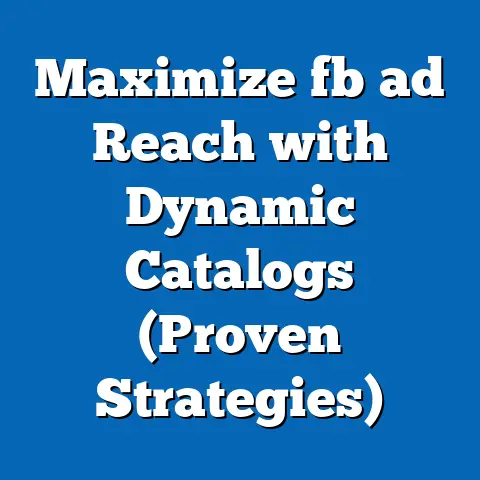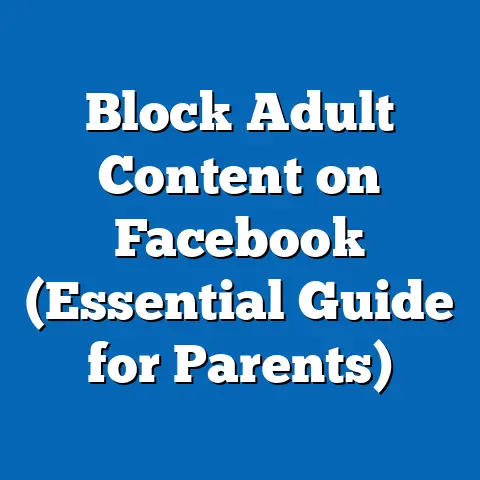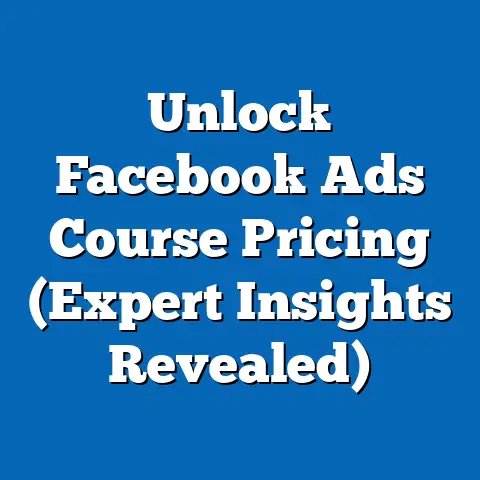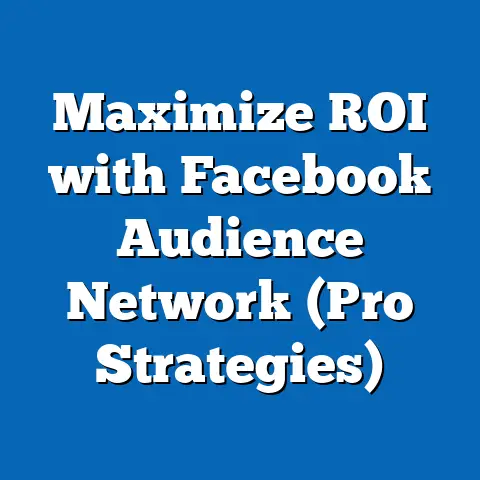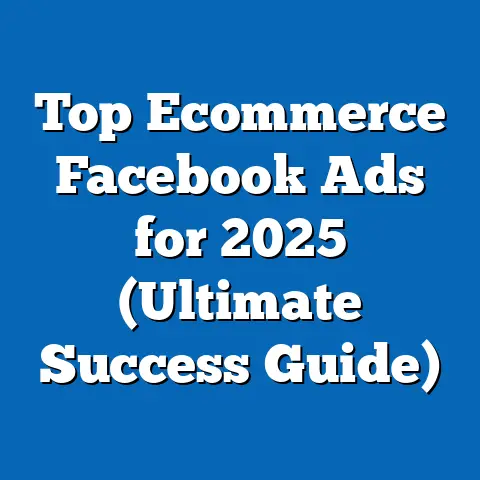Master Facebook Ads on Instagram (Pro Strategies Revealed)
In a world where attention spans are dwindling and competition is fierce, mastering Facebook Ads on Instagram is not just an option; it’s a necessity for any brand aiming for explosive growth and unparalleled engagement. I’ve seen firsthand how a well-crafted Instagram campaign can transform a business, taking it from obscurity to a thriving, recognized brand.
Instagram, with its visually-driven platform, offers a unique opportunity for brands to connect with their audience in a way that feels both authentic and engaging. Combined with the robust targeting capabilities of Facebook Ads Manager, you have a powerful tool at your disposal. This article isn’t just another guide; it’s a deep dive into advanced strategies I’ve personally used to elevate Facebook ad campaigns on Instagram, helping businesses like yours achieve remarkable results.
Section 1: Understanding the Facebook-Instagram Ecosystem
The integration between Facebook and Instagram is seamless, but it’s crucial to understand the nuances of each platform to maximize your advertising efforts. I remember when Facebook acquired Instagram; initially, many marketers were skeptical, but over time, it became clear that this synergy was a game-changer.
The Power of Integration
The backbone of running Instagram ads lies within Facebook Ads Manager. This centralized platform allows you to manage campaigns across both Facebook and Instagram, leveraging the same powerful targeting options, ad formats, and reporting tools.
- Unified Targeting: You can target users based on demographics, interests, behaviors, and even custom audiences built from your website visitors or customer lists. This means you can reach the exact people most likely to be interested in your products or services, regardless of which platform they prefer.
- Consistent Branding: Running ads through Facebook Ads Manager ensures a consistent brand experience across both platforms. You can use the same creative assets, messaging, and branding guidelines to maintain a cohesive identity.
- Streamlined Reporting: The Ads Manager provides a unified view of your campaign performance across both Facebook and Instagram. This allows you to easily compare results, identify trends, and optimize your campaigns for maximum ROI.
Instagram’s Visual Appeal
While Facebook is a diverse platform with various content types, Instagram is primarily a visual medium. Users come to Instagram to discover visually appealing content, connect with influencers, and stay updated on the latest trends. This unique characteristic requires a different approach to advertising.
- Visual Storytelling: Instagram is all about visual storytelling. Your ads need to capture attention instantly with high-quality images, videos, or engaging animations. Think about telling a story that resonates with your audience and showcases the value of your product or service.
- Authenticity is Key: Instagram users are savvy and can quickly spot inauthentic content. Your ads need to feel genuine and align with the platform’s culture. Focus on creating content that feels organic and adds value to the user’s experience.
- Mobile-First Mindset: Instagram is primarily a mobile platform. Your ads need to be optimized for mobile viewing, with clear visuals, concise copy, and easily accessible calls-to-action.
Audience Demographics: Know Your Crowd
Understanding the demographics of both Facebook and Instagram is essential for crafting effective ad campaigns. While there is some overlap, each platform attracts a distinct audience.
- Instagram: Younger and More Visual: Instagram tends to attract a younger audience, with a higher concentration of users in the 18-34 age range. These users are often visually oriented, interested in fashion, lifestyle, travel, and entertainment.
- Facebook: Broader and More Diverse: Facebook has a broader demographic reach, with users of all ages and backgrounds. This platform is often used for connecting with friends and family, staying updated on news and events, and engaging with communities.
Knowing these differences allows you to tailor your ad campaigns to the specific audience on each platform. For example, if you’re targeting young adults interested in fashion, Instagram would be the ideal platform. If you’re targeting a broader audience with a focus on community engagement, Facebook might be more suitable.
Takeaway: Understand the integrated nature of Facebook and Instagram advertising, but always tailor your content to the unique characteristics and audience of each platform.
Section 2: Crafting Compelling Visuals for Instagram Ads
In the realm of Instagram advertising, visuals reign supreme. They are the first (and often only) point of contact with your potential customer. I’ve learned that investing in high-quality visuals is not just a recommendation; it’s an absolute necessity.
The Power of First Impressions
On Instagram, you have mere seconds to capture a user’s attention as they scroll through their feed. A visually appealing ad can stop them in their tracks and pique their interest. On the other hand, a poorly designed ad can be easily overlooked.
- High-Quality is Non-Negotiable: Blurry images, pixelated videos, and amateurish designs are a surefire way to turn off potential customers. Invest in professional photography, videography, and graphic design to create visuals that stand out.
- Tell a Story: Your visuals should tell a story that resonates with your audience. Think about the emotions you want to evoke and the message you want to convey. Use visuals to showcase the benefits of your product or service and how it can improve the user’s life.
- Showcase Your Brand: Your visuals should reflect your brand’s identity and values. Use consistent colors, fonts, and imagery to create a cohesive brand experience.
Exploring Instagram Ad Formats
Instagram offers a variety of ad formats, each with its own unique strengths and weaknesses. Experimenting with different formats is essential for finding what works best for your brand and target audience.
- Stories Ads: These full-screen ads appear between users’ Stories. They are highly engaging and offer a great opportunity for showcasing your brand’s personality. I’ve found that short, attention-grabbing videos tend to perform best in Stories.
- Photo Ads: These ads appear in the user’s feed and consist of a single image. They are simple, yet effective, for showcasing your product or service. Use high-quality images that capture attention and convey your message clearly.
- Video Ads: These ads also appear in the user’s feed and can be up to 60 seconds long. They are great for telling a more detailed story and showcasing the benefits of your product or service in action.
- Carousel Ads: These ads allow users to swipe through multiple images or videos in a single ad unit. They are great for showcasing a range of products or highlighting different features of a single product.
- Reels Ads: These short-form video ads appear in the Reels tab and can be highly engaging, especially for reaching younger audiences.
Case Studies: Visual Success Stories
Let’s take a look at some successful Instagram ad campaigns that utilized compelling visuals:
- Airbnb: Airbnb’s Instagram ads often feature stunning photos of unique properties around the world. These visuals inspire wanderlust and showcase the platform’s unique offerings.
- Nike: Nike’s Instagram ads feature high-energy videos of athletes pushing their limits. These visuals are inspiring and align with the brand’s message of empowerment.
- GoPro: GoPro’s Instagram ads feature breathtaking videos and photos captured with their cameras. These visuals showcase the capabilities of their products and inspire users to capture their own adventures.
Branding and Consistency
Maintaining a consistent brand aesthetic is crucial for building brand recognition and trust on Instagram. Your ads should align with your overall brand identity and feel like a natural extension of your organic content.
- Use Consistent Colors: Choose a color palette that reflects your brand’s personality and stick to it across all of your visuals.
- Use Consistent Fonts: Choose a few fonts that represent your brand and use them consistently in your ad copy and graphics.
- Maintain a Consistent Tone: Your visuals should reflect your brand’s tone and voice. Are you playful and fun, or serious and professional?
Takeaway: Invest in high-quality visuals, experiment with different ad formats, and maintain a consistent brand aesthetic to create Instagram ads that capture attention and drive results.
Section 3: Targeting Your Audience Like a Pro
Facebook’s targeting options are, in my opinion, the secret weapon of successful Instagram advertising. You can have the most beautiful visuals and compelling copy, but if you’re not showing your ads to the right people, they won’t convert.
Broad vs. Niche Targeting
One of the first decisions you’ll need to make is whether to use broad or niche targeting. Each approach has its own advantages and disadvantages, and the best choice will depend on your specific goals and target audience.
- Broad Targeting: This approach involves targeting a wide range of users based on basic demographics like age, gender, and location. It’s useful for reaching a large audience and building brand awareness. However, it can also be less efficient, as you’ll be showing your ads to many people who are not interested in your product or service.
- Niche Targeting: This approach involves targeting a specific group of users based on their interests, behaviors, and demographics. It’s useful for reaching a highly qualified audience and driving conversions. However, it can also be more expensive, as you’ll be competing with other advertisers targeting the same audience.
I’ve found that a combination of both approaches can be effective. Start with broad targeting to build awareness, then refine your targeting based on performance data to reach a more qualified audience.
Custom Audiences and Lookalike Audiences
Facebook’s custom audiences and lookalike audiences are powerful tools for reaching the right people on Instagram.
- Custom Audiences: These audiences are built from your existing customer data, such as email lists, website visitors, or app users. They allow you to target people who have already interacted with your brand, making them more likely to convert.
- Lookalike Audiences: These audiences are created by Facebook based on the characteristics of your custom audiences. Facebook identifies users who are similar to your existing customers and targets them with your ads. This is a great way to expand your reach and find new customers who are likely to be interested in your product or service.
Retargeting: The Power of Second Chances
Retargeting is a strategy that involves showing ads to users who have previously engaged with your brand, such as visiting your website, watching a video, or adding items to their cart. It’s a highly effective way to drive conversions, as you’re targeting people who have already shown interest in your product or service.
- Website Retargeting: This involves showing ads to users who have visited your website. You can target them with ads that promote the products or services they viewed, or with ads that offer a discount or special offer.
- Video Retargeting: This involves showing ads to users who have watched a video on your Instagram page. You can target them with ads that promote the product or service featured in the video, or with ads that offer a free trial or demo.
- Cart Abandonment Retargeting: This involves showing ads to users who have added items to their cart but haven’t completed the purchase. You can target them with ads that remind them of the items they left behind, or with ads that offer a discount or free shipping.
Instagram Insights and Facebook Analytics
Instagram Insights and Facebook Analytics provide valuable data that can help you refine your targeting strategies.
- Instagram Insights: This tool provides data on your followers, their demographics, and their engagement with your content. You can use this data to understand your audience better and tailor your ads accordingly.
- Facebook Analytics: This tool provides data on your website traffic, app usage, and customer behavior. You can use this data to understand how users are interacting with your brand and identify opportunities for improvement.
Takeaway: Master Facebook’s targeting options to reach the right audience on Instagram. Use custom audiences, lookalike audiences, and retargeting to maximize your conversion rates. Continuously analyze your data to refine your targeting strategies and improve your ROI.
Section 4: Writing Copy That Converts
While visuals are crucial on Instagram, don’t underestimate the power of well-crafted ad copy. I’ve seen countless campaigns where a simple change in the ad copy resulted in a significant boost in conversions.
The Art of Persuasion
Your ad copy is your opportunity to persuade users to take action. It should be clear, concise, and compelling, highlighting the benefits of your product or service and encouraging users to click through to your website.
- Focus on Benefits, Not Features: Instead of listing the features of your product or service, focus on the benefits it provides to the user. How will it improve their life? What problem does it solve?
- Use Strong Verbs: Use strong verbs that create a sense of urgency and excitement. Words like “discover,” “transform,” and “achieve” can be highly effective.
- Keep it Concise: Instagram users are scrolling through their feeds quickly. Your ad copy needs to be short and to the point. Get to the point quickly and highlight the most important information.
Calls-to-Action (CTAs): Guiding the User
A call-to-action (CTA) is a phrase that encourages users to take a specific action, such as “Shop Now,” “Learn More,” or “Sign Up.” It’s essential to include a clear CTA in your ad copy to guide users towards your desired outcome.
- Use Action-Oriented Language: Your CTA should use action-oriented language that encourages users to click.
- Make it Prominent: Your CTA should be prominent and easy to see. Use a different color or font to make it stand out.
- Test Different CTAs: Experiment with different CTAs to see which ones perform best.
Examples of High-Performing Ad Copy
Let’s take a look at some examples of high-performing ad copy and analyze what makes them successful:
- “Transform your skin with our new serum. See visible results in just 7 days! Shop Now.” This ad copy focuses on the benefits of the product, uses strong verbs, and includes a clear CTA.
- “Discover the secret to a perfect cup of coffee. Our premium beans are sourced from the finest farms around the world. Learn More.” This ad copy creates a sense of intrigue, highlights the product’s unique selling proposition, and includes a clear CTA.
- “Sign up for our free trial and experience the power of our software. Start your free trial today!” This ad copy offers a valuable incentive, uses action-oriented language, and includes a clear CTA.
A/B Testing: The Key to Optimization
A/B testing involves creating two different versions of your ad copy and testing them against each other to see which one performs best. It’s a valuable tool for optimizing your ad copy and improving your conversion rates.
- Test Different Headlines: Experiment with different headlines to see which ones capture attention and drive clicks.
- Test Different CTAs: Experiment with different CTAs to see which ones encourage users to take action.
- Test Different Benefits: Experiment with highlighting different benefits of your product or service to see which ones resonate most with your audience.
Takeaway: Craft compelling ad copy that highlights the benefits of your product or service, uses strong verbs, and includes a clear CTA. A/B test different versions of your ad copy to optimize your conversion rates.
Section 5: Budgeting and Bidding Strategies
Understanding budgeting and bidding strategies is essential for running successful Instagram ad campaigns. I’ve seen businesses waste a lot of money by not properly managing their ad spend.
Budgeting Options
Facebook Ads Manager offers two main budgeting options:
- Daily Budget: This option allows you to set a daily budget for your ad campaign. Facebook will spend approximately this amount each day.
- Lifetime Budget: This option allows you to set a total budget for your ad campaign. Facebook will spend this amount over the entire duration of the campaign.
The best option for you will depend on your specific goals and how actively you plan to manage your campaigns. If you’re just starting out, a daily budget might be a good option, as it allows you to control your spending more closely. If you’re running a longer-term campaign, a lifetime budget might be more convenient.
Bidding Strategies
Facebook offers several bidding strategies, each designed to achieve different goals:
- Lowest Cost: This strategy aims to get you the most results for your budget. Facebook will automatically bid on your behalf, trying to find the lowest cost opportunities.
- Cost Cap: This strategy allows you to set a maximum cost per result. Facebook will try to get you results at or below your target cost.
- Bid Cap: This strategy allows you to set a maximum bid for each auction. Facebook will never bid more than your specified amount.
- Target Cost: This strategy aims to get you results at your target cost. Facebook will adjust your bids to try to achieve this goal.
The best bidding strategy for you will depend on your specific goals and your level of experience with Facebook Ads Manager. If you’re just starting out, the “Lowest Cost” strategy might be a good option. As you gain more experience, you can experiment with other strategies to optimize your results.
Optimizing Ad Spend
Here are some tips for optimizing your ad spend and achieving maximum ROI:
- Monitor Your Performance: Regularly monitor your campaign performance to see which ads are performing well and which ones are not.
- Adjust Your Bids: If your ads are not performing well, try adjusting your bids. You might need to increase your bids to get more visibility, or decrease your bids to save money.
- Refine Your Targeting: If your ads are not reaching the right audience, try refining your targeting. Make sure you’re targeting the right demographics, interests, and behaviors.
- A/B Test Your Ads: A/B test different versions of your ads to see which ones perform best. Experiment with different visuals, ad copy, and CTAs.
- Use Budget Pacing: Facebook’s budget pacing feature helps you distribute your budget evenly throughout the day. This can help you avoid spending your entire budget in the morning and missing out on opportunities later in the day.
Takeaway: Understand the different budgeting and bidding options available on Facebook Ads Manager. Optimize your ad spend by monitoring your performance, adjusting your bids, refining your targeting, and A/B testing your ads.
Section 6: Measuring Success and Optimizing Campaigns
Measuring the success of your Instagram ad campaigns is crucial for understanding what’s working and what’s not. I’ve seen businesses make huge improvements in their ROI simply by paying closer attention to their metrics.
Key Performance Indicators (KPIs)
Here are some key performance indicators (KPIs) to track for your Instagram ads:
- Reach: The number of unique users who saw your ad.
- Impressions: The number of times your ad was displayed.
- Frequency: The average number of times each user saw your ad.
- Click-Through Rate (CTR): The percentage of users who clicked on your ad after seeing it.
- Cost Per Click (CPC): The average cost you paid for each click on your ad.
- Conversions: The number of users who completed a desired action after clicking on your ad, such as making a purchase or signing up for a newsletter.
- Cost Per Conversion (CPC): The average cost you paid for each conversion.
- Return on Ad Spend (ROAS): The amount of revenue you generated for every dollar you spent on advertising.
Analyzing Ad Performance
Facebook Ads Manager provides a wealth of data that you can use to analyze your ad performance. You can view data on your reach, impressions, CTR, CPC, conversions, ROAS, and more. You can also segment your data by demographics, interests, and behaviors to understand which audiences are responding best to your ads.
- Identify Trends: Look for trends in your data. Are certain ads performing better than others? Are certain audiences more responsive to your ads?
- Compare Results: Compare your results to your previous campaigns. Are you improving over time?
- Benchmark Against Industry Averages: Compare your results to industry averages. Are you performing above or below average?
Data-Driven Decisions
Use your data to make data-driven decisions about your ad campaigns. If an ad is not performing well, don’t be afraid to pause it or make changes. If an audience is not responding to your ads, try refining your targeting.
- Optimize Your Visuals: If your CTR is low, try changing your visuals. Use higher-quality images or videos that are more visually appealing.
- Improve Your Ad Copy: If your conversion rate is low, try improving your ad copy. Highlight the benefits of your product or service and include a clear CTA.
- Refine Your Targeting: If your ads are not reaching the right audience, try refining your targeting. Make sure you’re targeting the right demographics, interests, and behaviors.
- Adjust Your Bids: If your ads are not performing well, try adjusting your bids. You might need to increase your bids to get more visibility, or decrease your bids to save money.
Post-Campaign Analysis
After your campaign has ended, conduct a post-campaign analysis to inform future strategies. Review your results and identify what worked well and what didn’t.
- What were your key takeaways? What did you learn from this campaign?
- What would you do differently next time? What changes would you make to improve your results?
- How can you apply these learnings to future campaigns? How can you use this information to improve your overall advertising strategy?
Takeaway: Track your KPIs, analyze your ad performance, and make data-driven decisions to optimize your Instagram ad campaigns. Conduct post-campaign analysis to inform future strategies and improve your overall advertising results.
Conclusion
Mastering Facebook Ads on Instagram is a critical skill for marketers and business owners who want to reach a wider audience, drive conversions, and build brand awareness. I’ve seen firsthand how businesses can transform their results by implementing the strategies outlined in this article.
With the right strategies and continuous learning, anyone can achieve remarkable results through effective Instagram advertising. Don’t be afraid to experiment, test different approaches, and learn from your mistakes. The key is to stay persistent, stay curious, and never stop learning.
Take actionable steps using the strategies discussed in this article to boost your advertising success on Instagram. Start by understanding the Facebook-Instagram ecosystem, crafting compelling visuals, targeting your audience like a pro, writing copy that converts, optimizing your budget and bidding strategies, and measuring your success.
The world of Facebook Ads on Instagram is constantly evolving, so it’s important to stay up-to-date on the latest trends and best practices. By following these strategies and continuously learning, you can achieve remarkable results and take your business to the next level. Now go out there and create some amazing Instagram ad campaigns!

